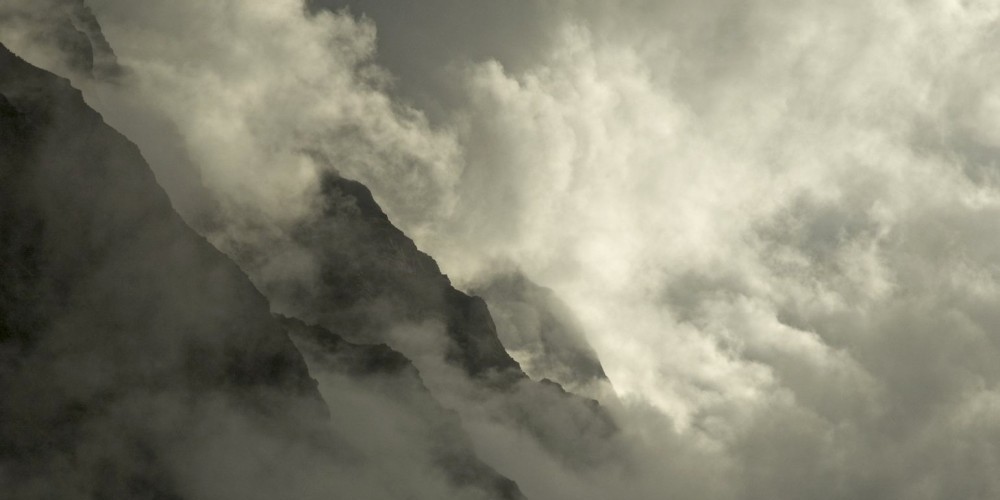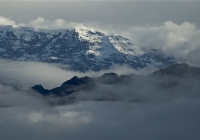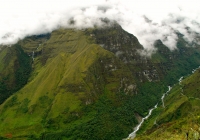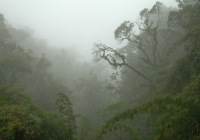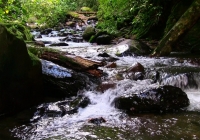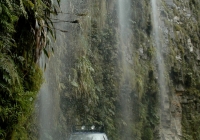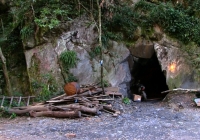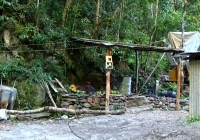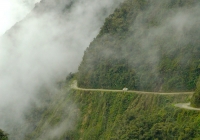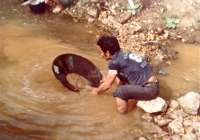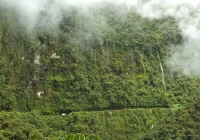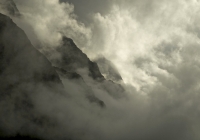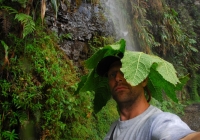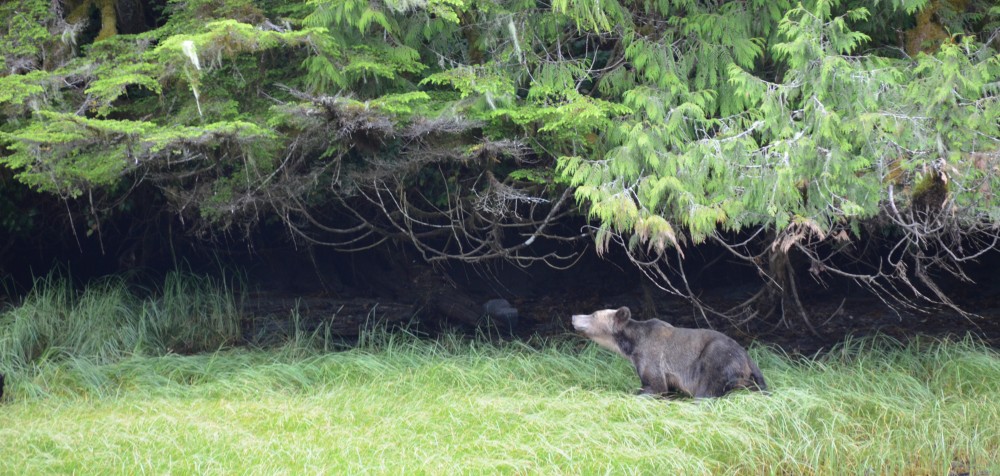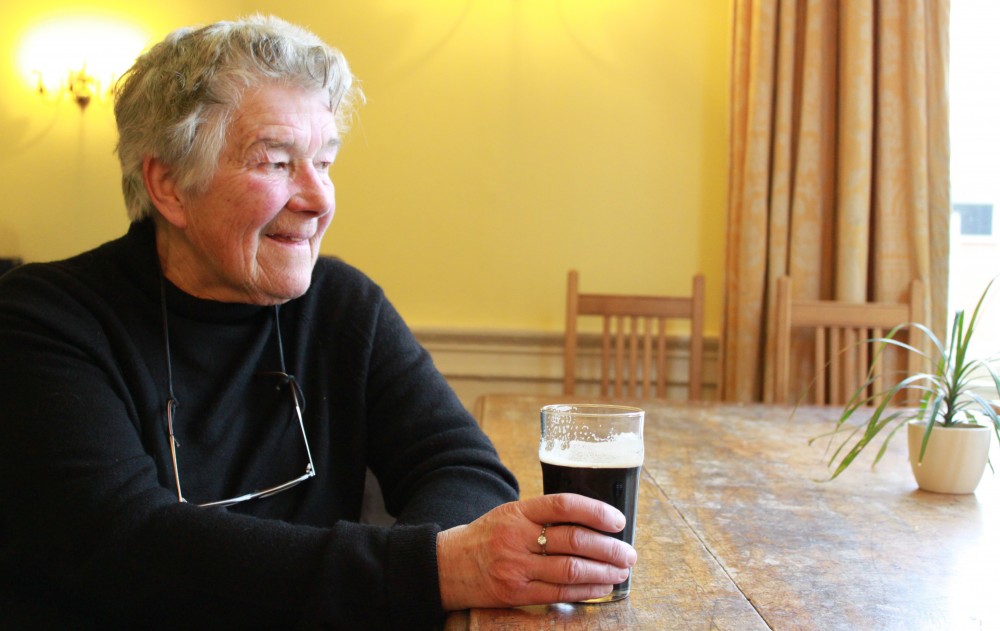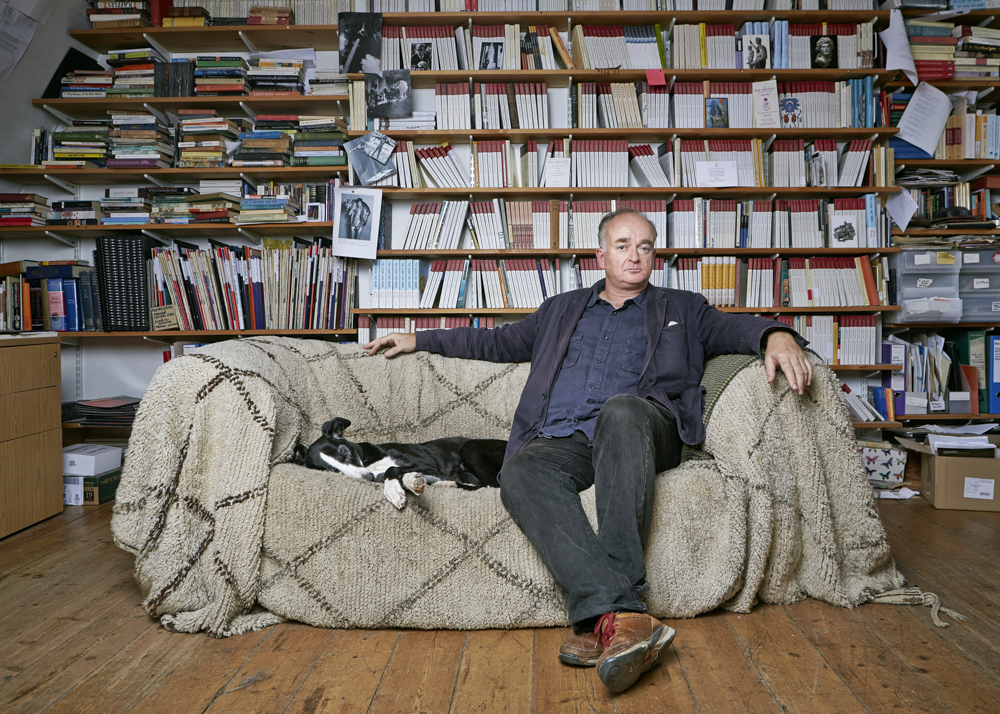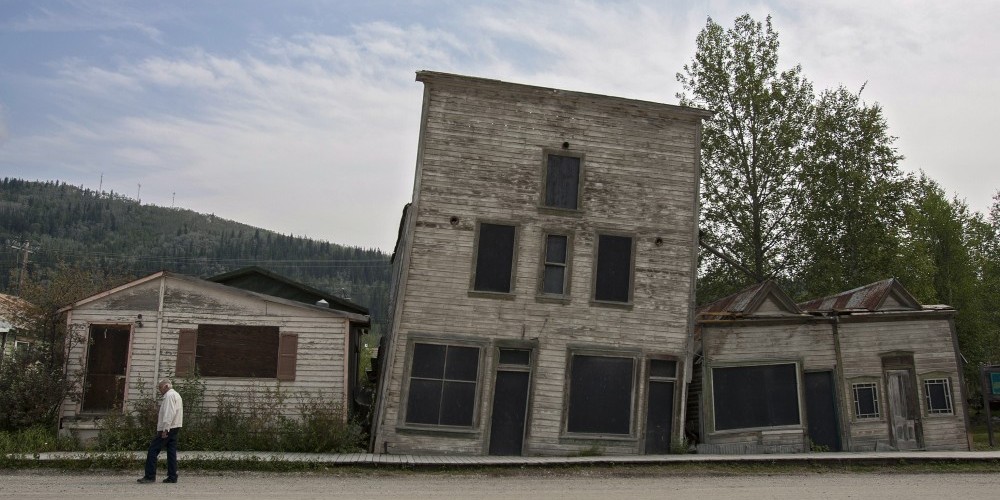In the fading light, the entrance of a goldmine gapes like an empty eye socket. A motorcycle is parked inside. Black wires leading into the mine power a couple of naked bulbs, illuminating the passageway gouged out of the rock. A large orange hose leads out of the mine, meandering 30 feet down the bank to belch its contents into the Huaranilla River. Nearby, several generators stand beneath a protective lean-to. A few foam mattresses are strewn about on the ground. Just beyond this are an open pit latrine and a refuse dump filled with whiskey bottles. Compared to other makeshift mines I’ve seen in the Yungas region of the Bolivian Andes, this one seems relatively well-funded and tidy.
I assume I’m trespassing, but curiosity has gotten the better of me. I’d spotted the mine—which hadn’t been here a few years ago—from across the river on the incoming drive, and I’m hoping to talk to the miners to learn more about the small operation, given it exists within the boundaries of Cotapata National Park. But the place appears abandoned. A hut constructed of chain-sawed boards seems unoccupied, but as I approach I hear the faint sound of snoring. It’s Sunday. Very likely it’s the caretaker who has already had his daily quota of whiskey and crashed for the night. The other miners are probably out spending time with family or getting sloshed in a bar across the river.
As night is falling and I have no flashlight, I begin the hike back up to the jungle hotel. A local madwoman once haunted these environs; if you ran into her she would mutter insults through gummy chops and sometimes throw dirt clods as you hurried by.
I pick up the pace. A shadow peels from the thick vegetation in front of me. It’s an agouti, a larger relative to the guinea pig. It stops to nibble at something, but as I approach it scurries back into the undergrowth. I find a half-eaten avocado on the ground, probably discarded by one of the miners.
A little farther along a small waterfall spills down a moss-slick cliff. It’s a humid July evening, so I pull off my camera and daypack and soak my head and shirt in the water. As I step back, I see the silhouettes of three men blocking the way. The cliff to my right denies any escape, so I grab my belongings, straighten my shoulders and march towards them, hoping that a confident guise will somehow protect me. My second thought is to pick up a rock. The silhouettes turn toward me.
“Jonatán, is that you?” says a familiar voice in Spanish.
“Fernando?” I say.
“Yeah, it’s me.”
I breathe a sigh of relief. It’s the owner of the jungle lodge where I’m staying, Fernando Querejazu, accompanied by two hotel employees. Although over fifty, Fernando’s well-muscled body makes him look ten years younger—he reminds me of the formidable Colonel Quaritch from the movie Avatar—only shorter and with a pony tail. He says he’s come down to inspect the riverfront.
“What are you doing here?” he says.
“Snooping around. I wanted to check out the mine back there. Do you have anything to do with it?”
“No, nothing.”
“Doesn’t this path run through your property?”
“Yes.”
“Did they negotiate a formal easement with you?”
“No. They already had the necessary government permissions.”
“How?
“To be honest, I don’t know,” Fernando says, rubbing a bicep. “But I have my suspicions. And what pisses me off, is that they have set up an illegal logging operation just above here.” He nods towards the waterfall.
The hauling in of mining equipment has chewed up the area and Fernando wants to restore and protect what he can. Behind a long government-installed retaining wall of caged river rock guarding the mine from the river a row of saplings has been planted. I ask him about the wall and all the other walls I’ve seen up and down the Huaranilla Valley.
“At first the retaining walls made sense, especially on the sharp river bends,” he says. “The water gets really high during the rainy season. But then it seemed like every curve was being fortified, and sometimes even the banks along the straightaways. Overkill, if you ask me.” His employees nod in agreement. “I suspect the river is being prepped for increased mining activity, like you see here, and future hydro projects.”
Back at the hotel, the power is out. Over Peruvian beers, Fernando explains that rolling power outages have become the norm.
“La Paz and El Alto are growing faster than its infrastructure can keep up,” he says. “When they run out of power, the Yungas all the way past Caranavi and into the lowlands tend to get the the short end of the stick.” The power goes out at least twice a week.
With the growing cities of La Paz and El Alto overtaxing existing hydro-electricity sources like the nearby Zongo Valley, the government has started eyeballing other catchments close to La Paz. Places like the Huaranilla Valley.
However, the valley and cloud forests of Cotapata National Park carry far greater importance as a source of fresh water, a commodity becoming increasingly rare in the highlands as a result of the rapid recession of Andean ice-pack. Glaciers I had once traversed in the eighties had now given way to bare rock. It’s no secret that Andean glaciers are disappearing faster than almost anywhere else on the globe. In the seventies and eighties, Bolivia boasted the world’s highest ski run on Chacaltaya Glacier. Now all that’s left is a shale slope and an abandoned lodge.
With over 80% of the world’s tropical glaciers, Ecuador, Peru and Bolivia have begun implementing an Adaptation to the Impact of Rapid Glacier Retreat in the Tropical Andes project funded by the World Bank and Japanese government. Besides studying the effects of climate change on Andean glaciers, the project undertakes small-scale risk assessments to demonstrate the benefits of water-saving techniques in farming, like line-drip irrigation. These efforts are coupled with training and a program to improve clean water distribution. But it’s already a life-or-death situation in cities like Bolivia’s El Alto, where up to 1000 households might share a single water outlet.
I’ve known Fernando for almost twenty years. In 1993, when the area was declared a national park, a ‘resource management’ provision allowed him and a handful of communities to continue to own private land within its boundaries. I witnessed how he took a small corner of jungle in the North Yungas, and turned it into a sizeable resort, a Flintstones meets Club Med affair, capable of accommodating over 600 people. Success comes with headaches, however, including what to do with the copious waste produced by hundreds of eating, purging guests, something for which the hotel has received criticism from environmentalists.
Fernando sheds light on the complex relationship between private landholders and the wildlife and resource management area of Cotapata National Park. The park encompasses an area of about 148,000 acres in a region as diverse as any in the world, ranging from Andean alpine to Amazon jungle. It comprises the southwestern portion of what is known as the Vilcabamba-Amboró Corridor, a crucial Andean watershed region straddling the Peru-Bolivia border. It also includes several areas of development: La Paz and El Alto 50 kilometres to the southwest and expanding coca-farming areas to the east (there is more coca growing in Bolivia now than before U.S. President Ronald Reagan’s War on Drugs began in the eighties). And since President Evo Morales’s inauguration in 2007, numerous new mining concessions have sprung up along the river valleys.
In the days that follow, my family and I visit the animal refuge of La Senda Verde and town of Coroico, taking us up and down the Huaranilla and Yolosa river valleys. I count at least half a dozen small mining operations.
I hate the site of these places. In the eighties, I’d experienced first hand how the onslaught of boom-bust gold mining poisoned streams and rivers. In 1982, I spent a month working with open-pit gold miners in the jungles near San Ramón in Bolivia’s eastern Amazon lowlands, where mercury amalgamation and leaching were widely practiced. Those were the days before the big companies moved into the area, when wildcat miners ruled, staking out claims or striking deals with existing claimants, Bolivia’s version of the Yukon Gold Rush.
I was sixteen at the time. My family moved to Bolivia in 1981 because my father had landed a job selling mining equipment out of La Paz. In those days, I wanted to be a field biologist like the great George B. Schaller, a man alone in the wild, free to observe the behaviour of animals from which to draw profound analogies for the benefit of Mankind. I suppose my father thought that casting me into a South American Heart of Darkness would bring me face-to-face with the grim realities of nature while building much-needed character. I guess it did. But it also nearly killed me. One day the main pit from which we extracted the ‘gold mud’—a 15’x15’ hole heading due south—collapsed, burying alive an unfortunate miner. After twenty minutes of frantic digging, we hauled his limp body from the pit, smeared in muddy vernix, mouth full of dirt. I wondered at how easily the land swallowed these gold-hungry earthworms.
During the day we’d pan the heavy gold mud extracted from the pit, sometimes separating out the gold with mercury, and then burning the mercury off in a crude smelter. I didn’t know it at the time, but the vapor created through this process was by far the most environmentally harmful byproduct of small pit gold mining; several of my fellow miners suffered from dreadful coughs, fevers and other pulmonary-related issues. At sundown, we’d head back to camp along the rutted road (which is now part of the Santa Cruz – Trinidad Highway).
Camp consisted of a couple open-air thatched huts. There had been heavy rains that month, and the roads were in terrible shape. As a result, supplies of rice, meat and tinned goods had not come through from Santa Cruz, so we resorted to living off of what we could fish from the mercury-laced streams—and what we could kill with a .22 caliber rifle. This included a hawk, a rare scarlet ibis, a Cuvier’s toucan, a beautiful Amazon squirrel and two six-banded armadillos. We had some charquay (jerky), draped over one of the hut supports, so infested with maggots that my fellow miners laughed about how a person had to literally cook it to death before eating it.
I befriended one of the younger miners, Juan, a Brazilian, who sported a Ché Guevara beard and a pistol strapped to one hip. During the down time after dark, in the light of a kerosene lamp we played poker with a Playboy Bunny adorned deck while exchanging sips from a bottle of Singani, Bolivian moonshine; or on weekends he’d drive me 27 treacherous kilometres into the nearest town on his 50cc motorbike for a treat of fried yucca and arroz con queso (rice and melted farmer’s cheese) and to meet the local girls. One clear Sunday morning, toco toucans croaking high in the treetops, instead of heading to town, Juan and I buzzed northward for several kilometres and pulled up in front of a questionable looking hut, where a cow with bulging udders tied to a small corral stood in a dismal state. Juan called out, shortly after which a woman with a loose-fitting top appeared, and between gaps in her teeth asked us what we wanted. I didn’t understand much Spanish in those days, but I knew enough to realize that Juan aimed to make a man out me. My head suddenly rife with graphic images of death-by-STD, I hastily declined the offer. Juan found my rejection terribly funny, as did the lady of the house. Juan asked, if I didn’t want to get laid, would I like some grenadine instead? Sure, I said. Anything would be better than a romp with that woman. He then proceeded to squirt milk straight from the tethered cow’s swollen teats into a glass the woman handed him, to which he added a bit of red liquid from a dirty plastic bottle, stirred it with a stick and handed it to me. It looked like strawberry phlegm. I drank it down in a couple of gulps. The woman winked at me and said I didn’t know what I was missing.
During one foray into the backcountry we met a grizzled man sporting a silver-plated pistol in a leather holster riding a white stallion. Patting the gun, the man had confessed, “I’m eighty years old and I recently killed a man.” Conversations in gold-mining country often started this way. A man’s reputation and gun were his best companions. “Over sixty years of mining I’ve collected two large Coke bottles full of gold,” he told us. “Several weeks ago, some imbécil broke into my house with the aim of stealing my Coke bottles. But I shot him dead, instead. To think that he actually thought I’d keep my gold in the house! What an idiot.”
Aside from a poor diet, life in the mining camp came with the incessant onslaught of insects, hot nights and the dreadful discovery of newly hatched worms called niguas feasting on my feet. When the food caught up to me I spent plenty of time in the bushes around camp emptying my bowels and picking up numerous ticks, one of which gorged itself on my scrotum. I thought I was going to die when I found the grape-sized critter. A resident mutt and her litter of puppies kept us entertained, while the fleas they carried infested our bedding. Vampire bats were frequent visitors at night. By the time my father arrived to pick me up at the end of my character-building month, I was a complete mess. I had an infected foot, I was bitten from head to toe, with heat rashes burning the inside of my arms and legs. My stomach was in disarray and something akin to the pox had mottled the skin on my face and transformed my lips into a flaking, cracked and bloody nightmare. I thought I might have chagas disease. My father took one look at me and said, “We’ve got to get you out of here.” The reward for my labours? Less than a gram of gold pressed into a dried clump of clay.
I did not become a biologist.
Exactly 31 years later, I have returned to Bolivia, family in tow, eager for them to experience the wonders of the Yungas. Fernando tells me that some new circuit trails have been developed for the benefit of more adventuresome guests. The next day, we find the trailhead a few hundred feet from the hotel cutting steeply up through the forest. As we climb, our boots squishing in the soft earth, the sweet smell of curry rises as the sun tries to break through the morning mists. Here and there we see a candy wrapper, or a pile of human excrement. Eventually we round the ridge and then the trail drops down into a small adjacent valley, at the bottom of which tumbles a sizeable stream.
Leaving my wife and daughter sunning themselves on some boulders, my son, Kai, and I wade up through the cool waters. After several curves all signs of human existence disappear and we are left with the symphony of forest and water sounds. The release is edifying, especially in the knowledge that there is no human habitation between here and the mountain summit at about 2700 metres—this water is about as clean as it gets, ironic, since it flows into the Huaranilla, a river in decline.
The release of mercury during gold extraction poses a serious threat to the environment and health of those living along the river. While it affects people living and working in gold-mining areas, these threats jeopardize life more significantly downstream in the Amazon Basin. In the late nineties, the mercury concentrations found in carnivorous fish in the Upper Beni River—into which the Huaranilla flows—exceeded four times the World Health Organization’s recommended safety levels; elevated mercury levels in six of eight human hair samples taken in the same area warned of the hazards of eating these tainted fish. More recent investigations suggest even higher levels today.
Our presence in this pristine part of the watershed feels like a sacrilege.
A little later, Kai and I descend the stream along the steep opposite bank. Before long, we pick up a freshly cut trail that eventually leads us into a clearing where several tree trunks lie in a heap. A few chain-sawed boards stacked to one side betray this as the miners’ illegal logging operation of which Fernando had spoken.
“It must take a long time to saw those boards with a chainsaw,” my son says. He’s thirteen. I muse over the thought of sending him to a logging camp in the Amazon for a month.
I do a bit of filming and then we meet up again with the girls to carry on back to the hotel.
Given what I’ve witnessed of the growing mining industry in the Huaranilla Valley, the designation of an integrated resource management area inside a Bolivian national park strikes me as oxymoronic, conservation with a front door thrown open to exploitation. But, as is often the case in developing countries, part of the soul of a place must sometimes be sacrificed if the heart of it is to be preserved. I’d seen this very scenario unfold in Bolivia’s Madidi, Noel Kempf Mercado, Isiboro-Securé and Carrasco-Amboró national parks, all important watershed regions.
Cotapata National Park is no exception. If anything, as a crucial watershed it faces a disproportionate amount of pressure from hyrdro-electricity developers, coca growers, tourists and miners. While each of these pressures have environmental implications, mining alone presents a categorically life-threatening scenario for the people downstream.
Before we depart for La Paz, I find myself back on the banks of the Huaranilla River, not far from the mine I’d visited a few days previously. I observe a lone heron perched on a boulder midstream. The thought that the fish that sustain it might be slowly killing it troubles me. Do toxins show up in feathers like they do in human hair?
Experts in mercury pollution of Andean rivers endorse a practical plan of action for Cotapata National Park. In order to cut down on mercury emissions, even small mines can install inexpensive, safe-to-operate mercury retorts, which effectively trap mercury during blow-torching of amalgam, thus preventing toxic substances from becoming airborne. Not only does the process reduce the risk of exposure to deadly vapours, but allows the miner to trap mercury for reuse. In other parts of the Bolivian Yungas, the use of such apparatuses has led to a significant drop in mercury emissions.
Two years ago a group of about 80 families formed the Cotapata Gold Mining Cooperative, now the first small-scale miners´ organization in the area certified to the Fairtrade and Fairmined standard for responsibly mined gold. Best practices require them to use mercury retorts in all gold extraction, a promising start.
The mine behind me might be part of this cooperative and I want to see one of the retorts in action. But I’m on holiday with my family and I have neither the time nor the spousal clearance to do my usual sleuthing. It will have to wait.
I turn to leave. Startled by my movement, in one swift and awkward thrust the heron takes flight and pounds it’s way upstream to disappear behind a clump of bamboo.
All the way back to the hotel, where my family waits, I feel like I’m racing the shadows edging up the steep, jungle-clad sides of the valley.
Jon Derksen spent his formative years in Malaysia, Japan, Canada and Bolivia. He has contributed to editions of Backpacking and Trekking in Peru and Bolivia (Bradt Publications) and he compiled Hiking in the Garhwal Himalayas: A Guide (Woodstock Publications). His writing and photography have appeared in South American Explorer Magazine, Geographical, GORP, The Bolivian Times and elsewhere. Work with National Geographic and Discovery Channel has taken him from the Andean highlands to the remote Indian state of Arunachal Pradesh. His passions include being a husband and father, teaching and leading student expeditions, and protecting watershed and coastal areas. Jon is currently working on Loggerheads, a young adult adventure novel about Belize’s barrier reef.

